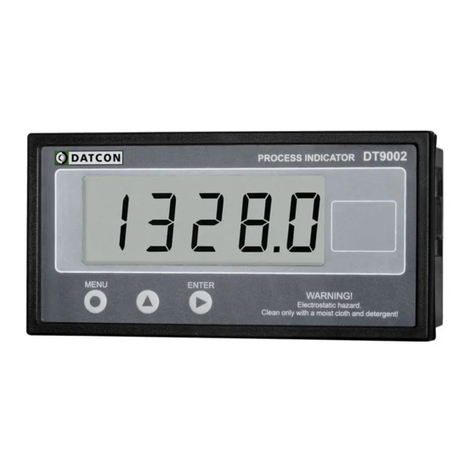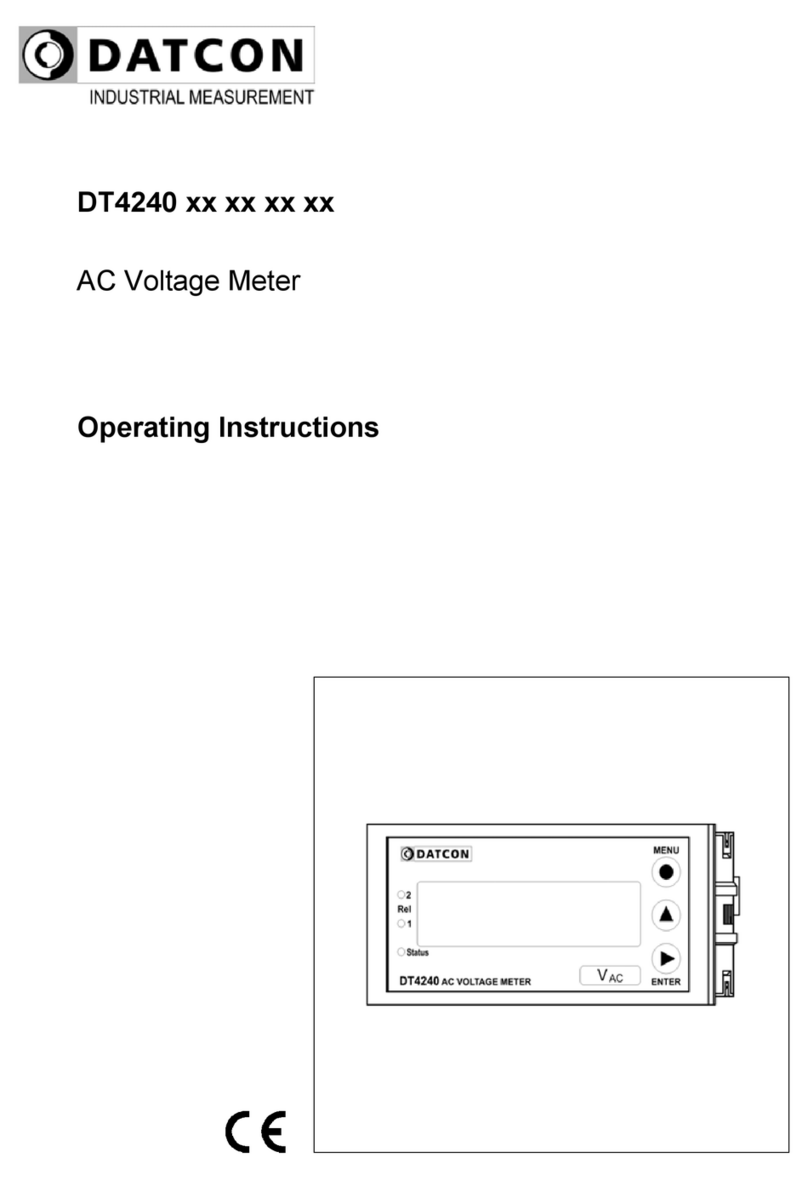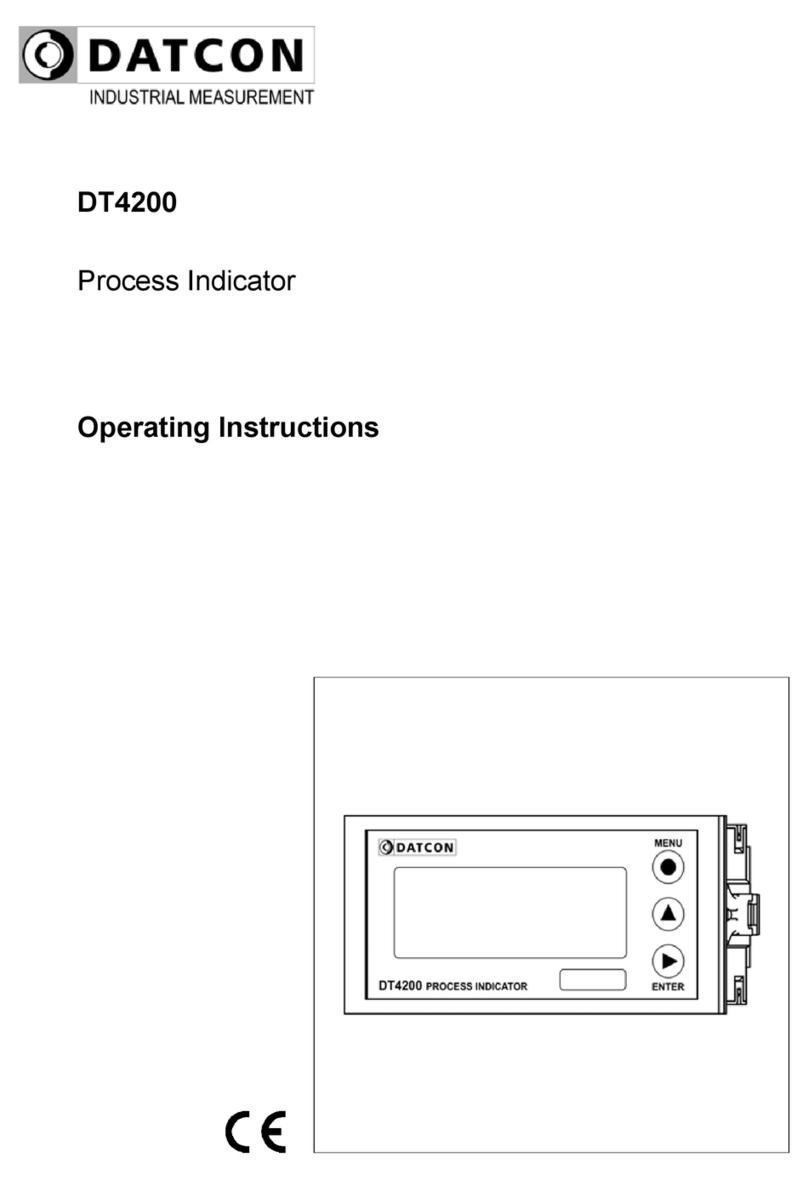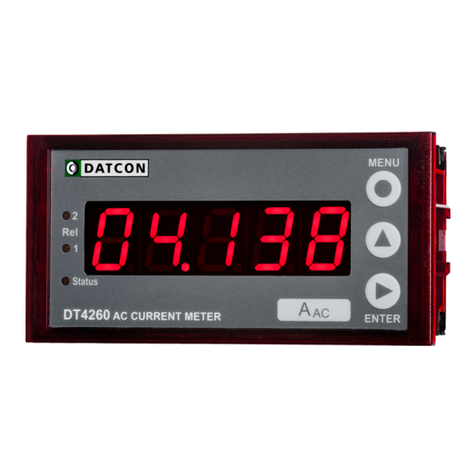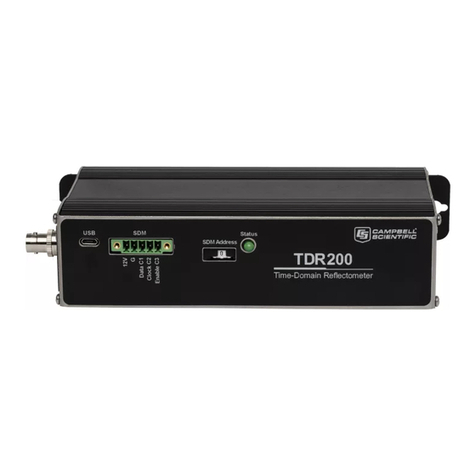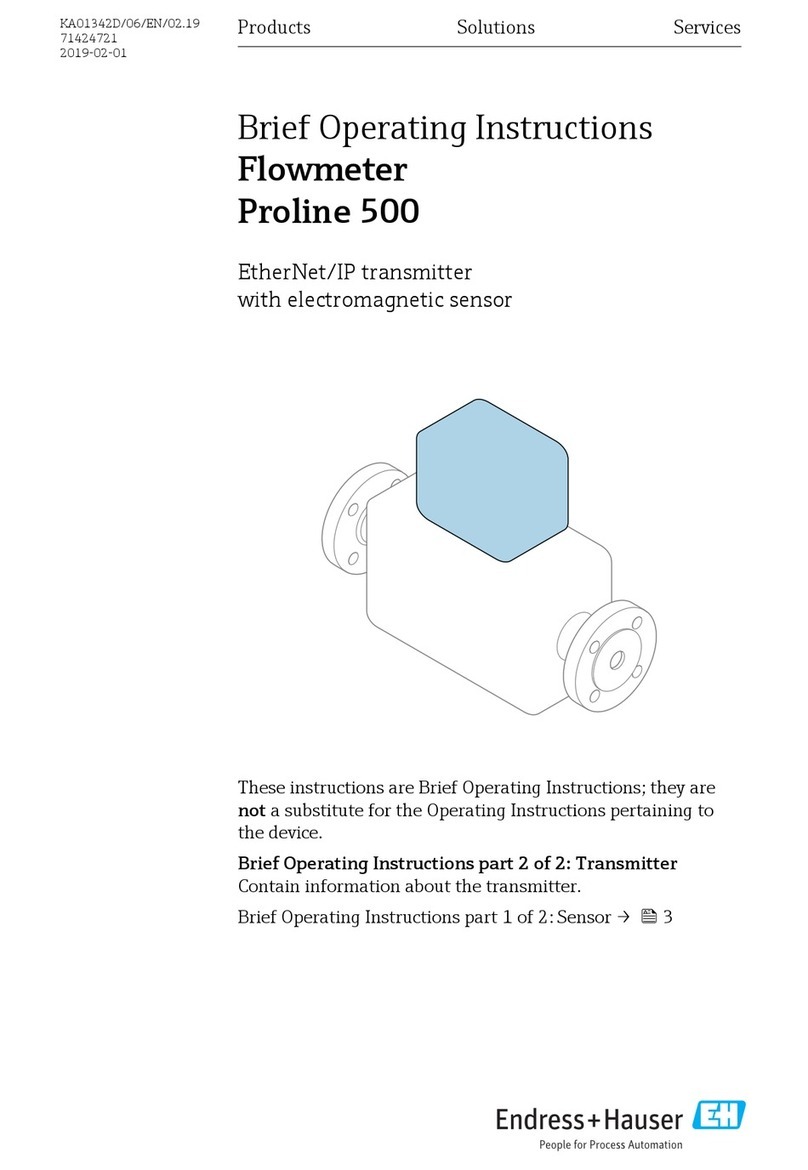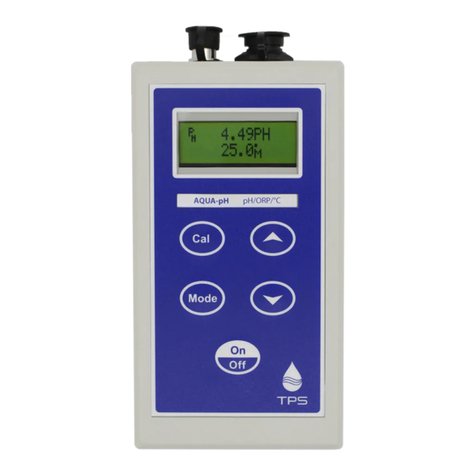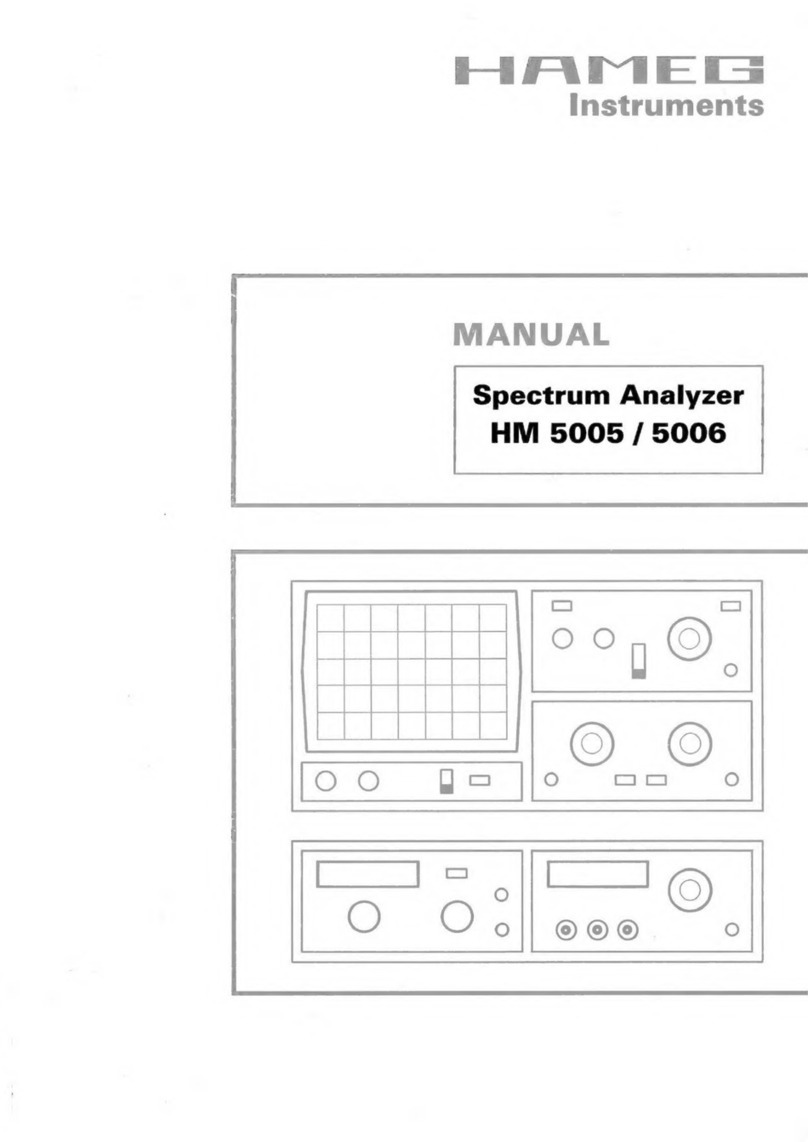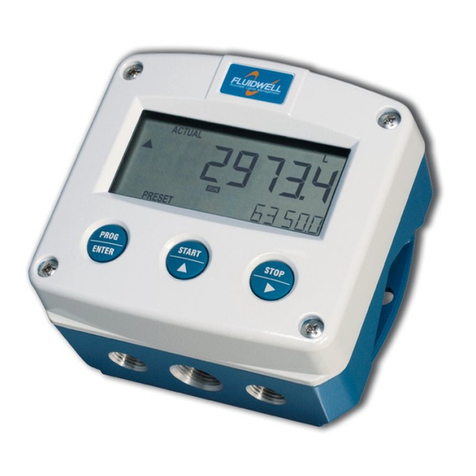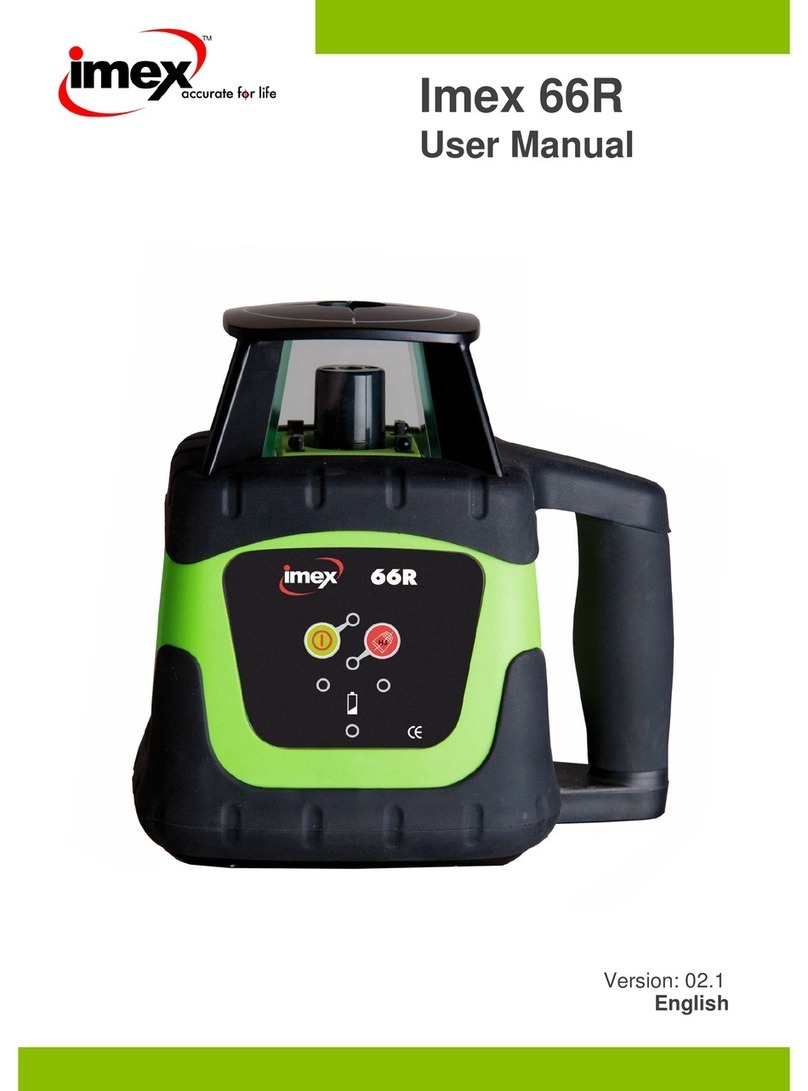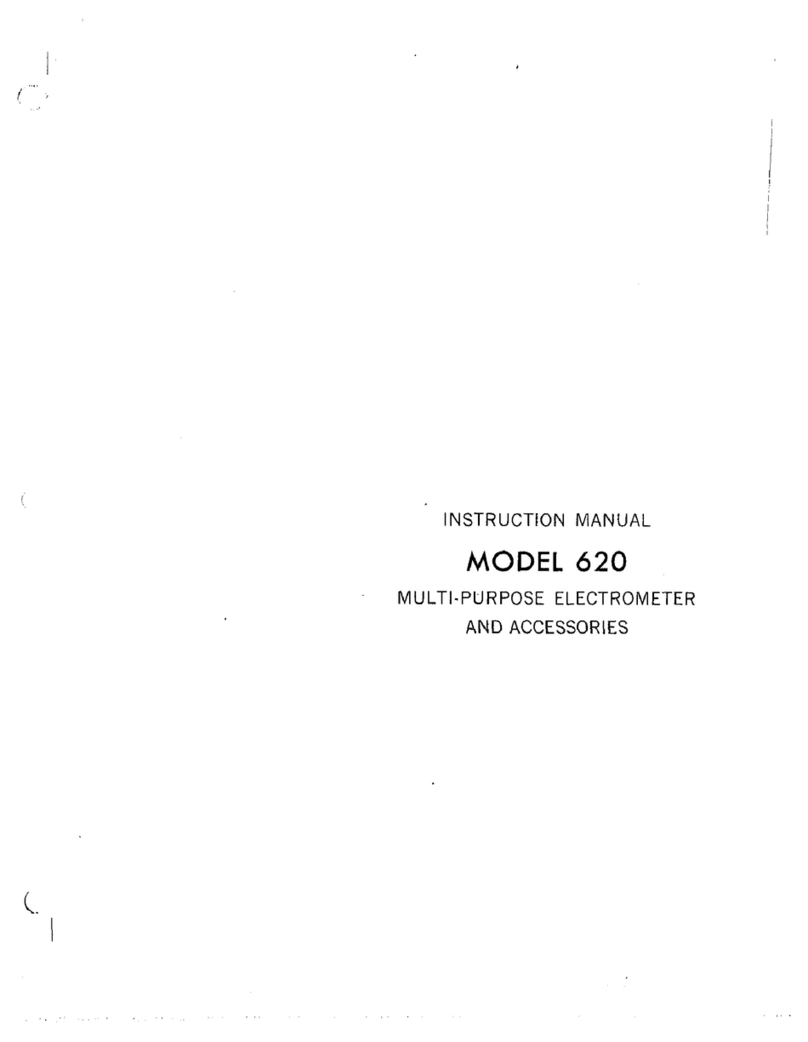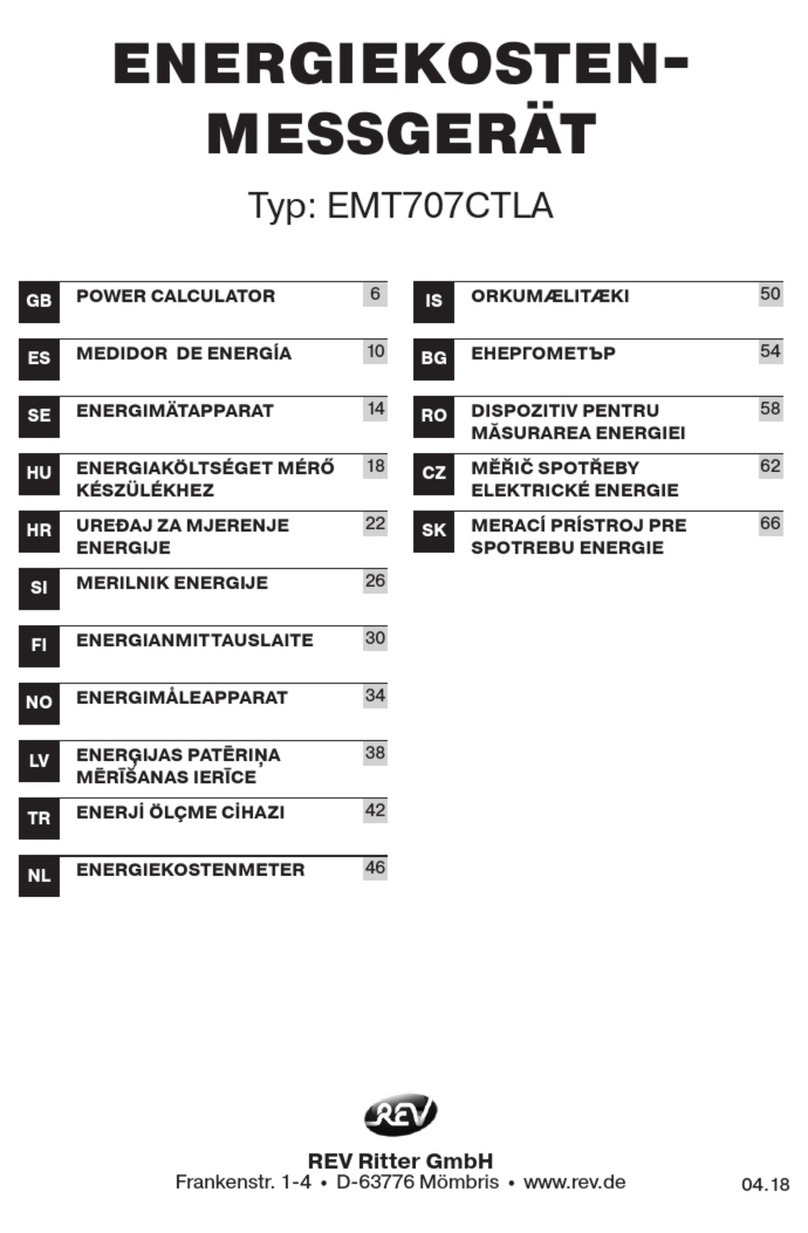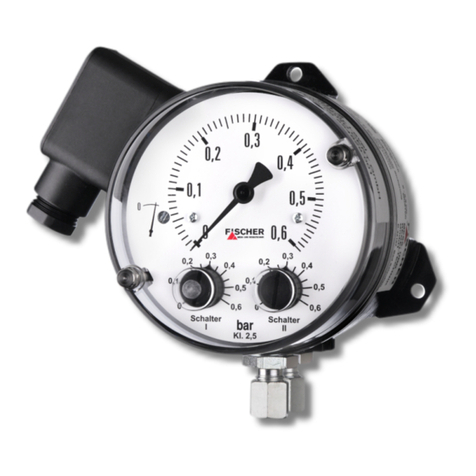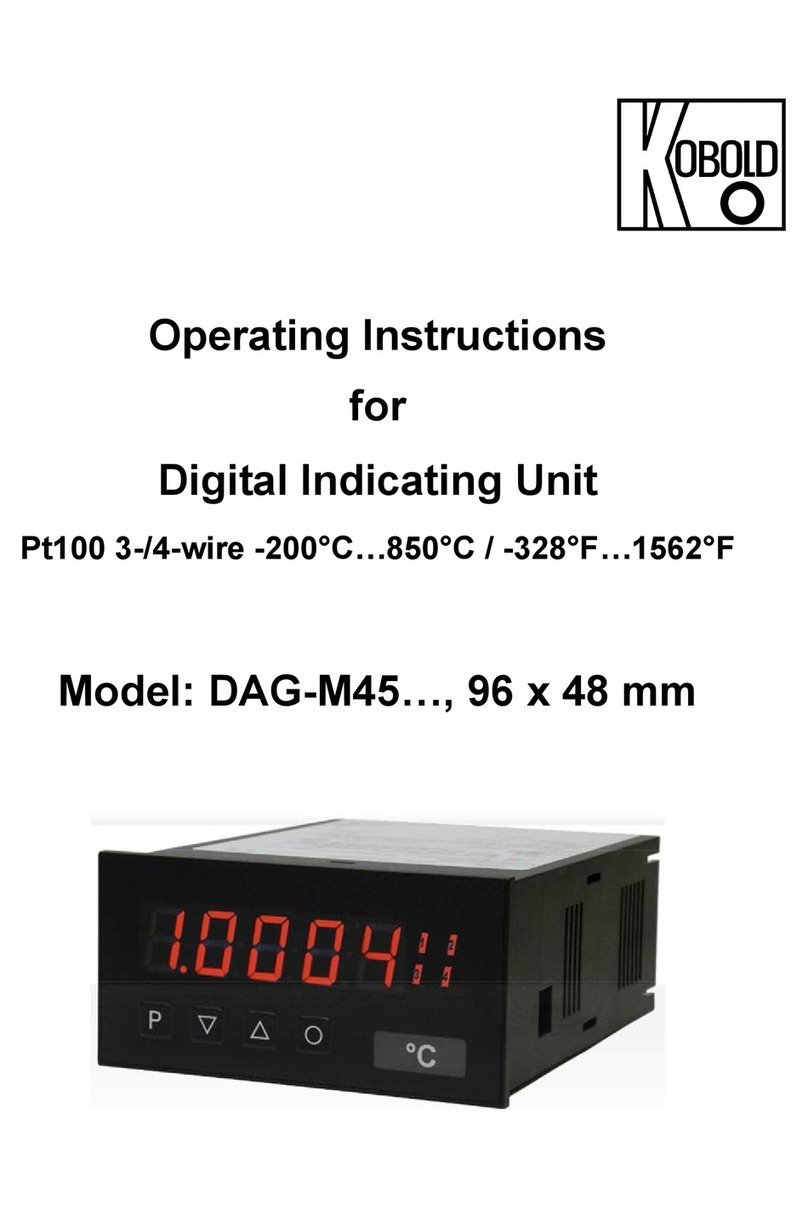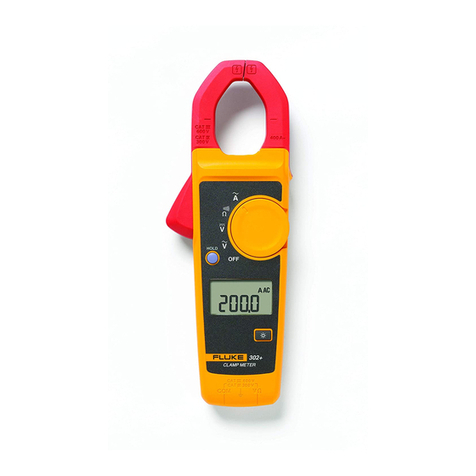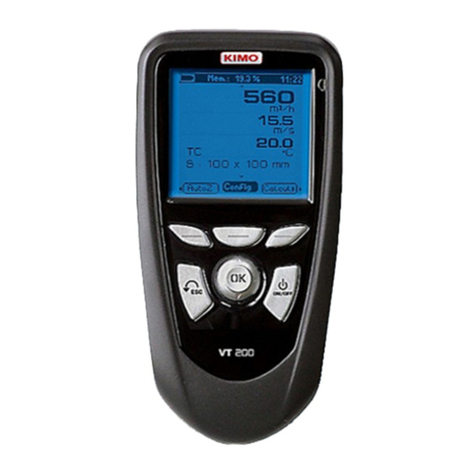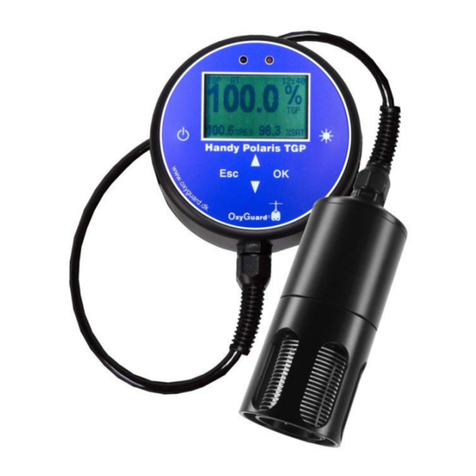Datcon PQRM5300 33 U I Series User manual

PQRM5300 33 Ux Ix xx xx (PS)
Three-phase Power Meter
Instruction manual

PQRM5300 33 Ux Ix xx xx (PS)
2 20201120-V1
Contents
1. About this document...................................................... 5
1.1. Function ................................................................................... 5
1.2. Target group............................................................................. 5
1.3. Symbolism used....................................................................... 5
2. For your safety................................................................ 6
2.1. Authorized personnel ............................................................... 6
2.2. Appropriate use........................................................................ 6
2.3. Warning about misuse ............................................................. 6
2.4. General safety instructions....................................................... 6
2.5. CE conformity........................................................................... 6
2.6. Environmental instructions....................................................... 6
3. Product description........................................................ 7
3.1. Delivery configuration............................................................... 7
3.2. Type designation...................................................................... 7
3.3. Operating principle................................................................... 8
3.4. Display, Indicators, keyboard................................................. 10
3.5. Storage and transport ............................................................ 11
4. Mounting........................................................................ 12
4.1. General instructions ............................................................... 12
4.2. Main dimensions of the instrument ........................................ 12
4.3. Mounting ................................................................................ 13
5. Connecting .................................................................... 15
5.1. Preparing the connection ....................................................... 15
5.2. Connecting the measuring inputs to power network. Three
phase measurement with neutral conductor. (3 phase, 4 wire, 3
measuring) .................................................................................... 16
5.3. Connecting the measuring inputs to power network. Three
phase measurement without neutral conductor. (3 phase, 3 wire, 3
measuring) .................................................................................... 17
5.4. Connecting the measuring inputs trough transformer to power
network. Three phase measurement with neutral conductor. (3
phase, 4 wire, 3 measuring).......................................................... 18

PQRM5300 33 Ux Ix xx xx (PS)
20201120-V1 3
5.5. Connecting the measuring inputs to medium voltage power
network. Three phase measurement without neutral conductor. (3
phase, 3 wire, 3 measuring).......................................................... 19
5.6. Connecting the measuring inputs to symmetrical three-phase
power network with neutral conductor. (3 phase, 4 wire, 1
measuring) .................................................................................... 20
5.7. Connecting the measuring inputs to symmetrical three-phase
power network without neutral conductor. (3 phase, 3 wire, 1
measuring) .................................................................................... 21
5.8. Aron mode (3 phase, 3 wire, 2 measuring)............................ 22
5.9. Connecting the measuring inputs to three-phase power
network trough three-phase voltage transformers without common
connection point (3 phase, 3 wire, 3 measuring, 3fmv)................. 23
5.10. Connecting the digital outputs.............................................. 24
5.11. Connecting to MODBUS RS485 network............................. 26
5.12. Connecting to ETHERNET network..................................... 27
5.13. Connecting the analog output to signal processing unit....... 28
5.14. Connecting the power supply............................................... 29
6. Setting – up ................................................................... 30
6.1. First steps............................................................................... 30
6.2. Main menu, Measured data ................................................... 31
6.3. Main menu, Energy menu...................................................... 33
6.4. Main menu, Harmonics menu ................................................ 33
6.5. Main menu, Errors menu........................................................ 33
6.6. Main menu, Power limit.......................................................... 34
6.7. Main menu, User settings menu ............................................ 35
6.8. Main menu, Configurations menu .......................................... 35
7. Settings.......................................................................... 36
7.1. General information................................................................ 36
7.1.1. Required settings ................................................................ 37
7.1.2. Entering numbers (Editing numbers) .................................. 38
7.2. Enter to User settings menu................................................... 39
7.2.1 Language selection.............................................................. 39
7.2.2. Setting the brightness of displaybacklight........................... 40
7.2.3. Editing the user displays ..................................................... 41

PQRM5300 33 Ux Ix xx xx (PS)
4 20201120-V1
7.3. Configurations menu.............................................................. 42
7.3.1 Measure input settings......................................................... 43
7.3.1.1. Measure configuration...................................................... 43
7.3.1.2. Voltage Transformers (VT) and Current Transformers
(CT) ratio settings......................................................................... 45
7.3.1.3. Phase lag of CT settings.................................................. 46
7.3.1.4. Sampling time setting....................................................... 47
7.3.1.5. Current threshold ............................................................. 48
7.4. Setting the optional modules.................................................. 49
7.4.1. Digital inputs and outputs settings ...................................... 49
7.4.1.1. Digital output, Energy pulse output settings..................... 50
7.4.1.2. Digital output, Energy sign output settings....................... 52
7.4.1.3. Digital output, Limit output settings .................................. 53
7.4.1.4. Digital output, Alarm output settings ................................ 56
7.4.1.5. Digital output, Demand control function setting................ 57
7.4.1.6. Digital output, digital output test....................................... 59
7.4.2. Analogue output settings..................................................... 60
7.4.2.1. Analogue output testing ................................................... 61
7.4.3. Communication interface .................................................... 63
7.4.3.1. MODBUS RS485 interface setting................................... 63
7.4.3.2. MODBUS TCP Ethernet interface setting ........................ 64
7.4.3.3 MODBUS registers format ................................................ 65
7.5. Error LED settings.................................................................. 80
7.6. Clear errors ............................................................................ 81
7.7. Clear the Energyregisters ...................................................... 82
7.8. Change the password ............................................................ 82
8. Fault rectification.......................................................... 83
8.1. Fault finding............................................................................ 83
8.2. Repairing................................................................................ 83
9. Dismounting .................................................................. 84
9.1. Dismounting procedure.......................................................... 84
9.2. Disposal ................................................................................. 85
10. Appendix...................................................................... 86
10.1. Technical specification......................................................... 86
10.2. MODBUS RS485 bus topology............................................ 90
10.3. Ethernet network topology ................................................... 91

PQRM5300 33 Ux Ix xx xx (PS)
20201120-V1 5
1. About this document
1.1. Function
This operating instructions manual has all the information
you need for quick set-up and safe operation of
PQRM5300 33 Ux Ix xx xx (PS).
Please read this manual before you start setup.
1.2. Target group
This operating instructions manual is directed to trained
personnel. The contents of this manual should be made
available to these personnel and put into practice by them.
1.3. Symbolism used
Information, tip, note
This symbol indicates helpful additional information.
Caution, warning, danger
This symbol informs you of a dangerous situation that could
occur. Ignoring this cautionary note can impair the person
and/or the instrument.
• List
The dot set in front indicates a list with no implied sequence.
→ Action
This arrow indicates a single action.
1
Sequence
Numbers set in front indicate successive steps in a
procedure.

PQRM5300 33 Ux Ix xx xx (PS)
6 20201120-V1
2. For your safety
2.1. Authorized personnel
All operations described in this operating instructions
manual must be carried out only by trained and authorized
specialist personnel. For safety and warranty reasons, any
internal work on the instruments must be carried out only by
DATCON personnel.
2.2. Appropriate use
The PQRM5300 33 Ux Ix xx xx (PS) is a Three-phase
Power Meter. Detailed information on the application range
is available in chapter 3. Product description.
2.3. Warning about misuse
Inappropriate or incorrect use of the instrument can give rise
to application-specific hazards, or damage to system
components through incorrect mounting or adjustment.
2.4. General safety instructions
The PQRM5300 33 Ux Ix xx xx (PS) is a high-tech
instrument requiring the strict observance of standard
regulations and guidelines.
The user must take note of the safety instructions in this
operating instructions manual, the country-specific
installation standards as well as all prevailing safety
regulations and accident prevention rules.
2.5. CE conformity
The PQRM5300 33 Ux Ix xx xx (PS)
is in conformity with the
provisions of the following standards:
MSZ EN 61010-1 (safety)
MSZ EN 61326-1 (EMC)
2.6. Environmental instructions
Protection of the environment is one of our most important
duties.
Please take note of the instructions written in the following
chapters:
• Chapter 3.5. Storage and transport
• Chapter 9.2. Disposal

PQRM5300 33 Ux Ix xx xx (PS)
20201120-V1 7
3. Product description
3.1. Delivery configuration
Delivered items The scope of delivery encompasses:
• PQRM5300 33 Ux Ix xx xx (PS)
• documentation:
this operating instructions
certification
warranty
3.2. Type designation

PQRM5300 33 Ux Ix xx xx (PS)
8 20201120-V1
3.3. Operating principle
Area of application A PQRM5300 33 Ux Ix xx xx (PS) Three-phase Power
Meter measure the characteristic for three-phase network
system. The measured values are displayed on a graphic
display, and they are forward for processing units.
Programming and adjustment are performed via the front
panel membrane keypad.
The current inputs of the instrument are isolated from the
network with wideband current transformers. The voltage
inputs of the instrument are galvanic connection in the
network. The PQRM5300 33 Ux Ix xx xx (PS) Three-phase
Power Meter has many measurement configurations.
Options:
• Two (4-20 mA / 0-20 mA) or (0-5 mA / 1-5 mA) galvanic
isolated, configurable, scalable analog output.
• RS485 galvanic isolated communication output with
MODBUS RTU / ASCII slave protocol. 32 instruments can
be connected to the PLC or to the computer.
• ETHERNET galvanic isolated communication output with
MODBUS TCP protocol.
One options can be installed (dual analog output or
communication output) at the same time.
Operating principle
The signals of voltage divider output and of current-
transformer output through the signal conditioner and
protection circuits are led to the 16 bit A/D converter inputs.
The digitalized signals are processed by the instruments
microcontroller. The calculated energy values (+E, -E, +RE,
-RE) and the settings are stored an EEPROM for an
unlimited period of time. The switched-mode power supply
of the instrument produces two galvanic isolated output
voltages: one for the instrument circuitry and one for the
installed options.
Power supply The instrument has two power supply version:
PQRM5300 33 Ux Ix xx xx 24 VDC
PQRM5300 33 Ux Ix xx xx PS: 230 V AC/DC

PQRM5300 33 Ux Ix xx xx (PS)
20201120-V1 9
Measuring parameters: Per phase:
• Ueff : Measured voltage of L1, L2, L3 phase [V]
• Ieff : Measured current of L1, L2, L3 phase [A]
• P: Measured active power of L1, L2, L3 phase [W]
• Q: Measured reactive power of L1, L2, L3 phase [VAr]
• S: Measured apparent power of L1, L2, L3 phase [VA]
• PF: Calculated power factor of L1, L2, L3 phase
• f: Measured network freuqvency [Hz]
• THDU: Calculated total harmonic distortion of phase
voltage (up to 19. harmonic ) [%]
• THDI:
Calculated total harmonic distortion of phase current
(up to 19. harmonic ) [%]
• +E: Measured values of consument active energy [Wh]
• -E: Measured values of produced active energy [Wh]
• +RE: Measured values of inductiv reactive energy [VArh]
• -RE: Measured values of capacitiv reactive energy [VArh]
• ΣP: Active power of three phase network [W]
• ΣQ: Reactive power of three phase network [Var]
• ΣS: Apparent power of three phase network [VA]
• ΣPF:Calculated power factor of three phase network
• Σ+E: Measured consument active energy of three phase
netwrok [Wh]
• Σ-E: Measured produced active energy of three phase
netwrok [Wh]
• +RE: Measured inductive reactive energy of three phase
netwrok [VArh]
• -RE: Measured capacitiv reactive energy of three phase
netwrok [VArh]
• U12, U23, U31, : Messaured voltage between phase to phase
• ρ12: Meassured phase angle between of L1 and L2
phase
• ρ13: Meassured phase angle between of L1 and L3 phase

PQRM5300 33 Ux Ix xx xx (PS)
10 20201120-V1
3.4. Display, Indicators, keyboard
The following figure shows the instruments front:
1. Monochrome graphic LCD to displaying the measured
value, menu points and the error messages.
2. Membrane keypad for navigation in the menu system,
selection for the menu items and entering numeric values
(F1-F4)
3. Indicators:
„Status” green indicator for indicating that device is ready.
„Error” red indicator for indicating that a kind of error
occurred.
„Com” yellow indicator for indicating that a successful data
exchange has granted through the communication output
(MODBUS),
„Pulse x” yellow indicator for indicating that pulse output is
in “on-state” (lights = output is close).

PQRM5300 33 Ux Ix xx xx (PS)
20201120-V1 11
3.5. Storage and transport
This instrument should be stored and transport in places
whose climatic conditions are in accordance with chapter
10.1. Technical specification as described under the title:
Environmental conditions.
The packaging of instrument consist of environment-
friendly, recyclable cardboard is used to protect the
instrument against the impacts of normal stresses occurring
during transportation. The corrugated cardboard box is
made from environment-friendly, recyclable paper. The
inner protective material is nylon, which should be disposed
of via specialized recycling companies.

PQRM5300 33 Ux Ix xx xx (PS)
12 20201120-V1
4. Mounting
4.1. General instructions
Use the enclosed seal between the instrument and the
panel when mounting the instrument to assure IP 54 from
the front. The instrument should be installed in a cabinet
with sufficient IP protection, where the operating conditions
are in accordance with chapter 10.1. Technical
specification, as described under the title: Operating
conditions.
Mounting position
Select a mounting position you can easily read the display
reach for mounting and connecting the instrument and that
minimizes the hazard of water, dust or dump getting into the
instrument.
4.2. Main dimensions of the instrument

PQRM5300 33 Ux Ix xx xx (PS)
20201120-V1 13
4.3. Mounting
Preparatory steps
The following figure shows the dimensions of panel cut-out:
(thickness: 2 - 5 mm)
Dimensions of panel
cutout
1. Cut-out the panel according to the figure shows above.
The cut-out needs special tools, it must be carried out by
trained specialist personnel.

PQRM5300 33 Ux Ix xx xx (PS)
14 20201120-V1
Before fitting the instrument into the panel cut-out it is
recommended to exercise the using of mounting clamps.
Put the instrument onto a table and follow the steps (from
step 2.) written under the figure:
Mounting with the
mounting clamps
Please do not exercise forces higher than necessary, as it
may cause damages to the clamp.
1. Pulsh in the instrument to the panel.
2. Insert the mounting clamp into the front rivet.
(according the figure Step (2))
3. Rotate the mounting clamp in the direction of the arrow
until it snaps into the groove in the rear mounting rivet.
(according the figure Step (3)
4. Screwing the fixing screw (clockwise) according the figure
Step (4).
5. Do the above procedure with the other mounting clamp
also (Step (1) - Step (4)).
Check the hold of the instrument in the panel cut-out by
moving on it firmly.

PQRM5300 33 Ux Ix xx xx (PS)
20201120-V1 15
5. Connecting
5.1. Preparing the connection
Always observe the following safety instructions:
• The connection must be carried out by trained and
authorized personnel only
• Connect only in the complete absence of supply voltage
• Take note the data concerning on the
overcurrent protection in installation
• Use only a screwdriver with appropriate head
Take note the suitability of the connecting cable
(wire cross-section, insulation, etc.).
The cross-section of the connecting wires specified in the
following table
connector wire cross-section
Main inputs 0,75–1,5 mm2
Voltage and current measurement
inputs
2,5–4,5 mm2
Analogue outputs 0,25–0,5 mm2
Communication outputs 0,35–0,5 mm2
Pulse outputs 0,35–0,5 mm2
Select and prepare
connection cable
You may use either solid conductor or flexible conductor.
In case of using flexible conductor use crimped wire end.
Strip approx. 8 mm insulation.
It’s an important rule that the power cables and signal
cables should lead on a separate way.

PQRM5300 33 Ux Ix xx xx (PS)
16 20201120-V1
5.2. Connecting the measuring inputs to
power network.
Three phase measurement with neutral conductor. (3
phase, 4 wire, 3 measuring)
The following figure shows the wiring plan, connecting the
instrument to low voltage power network with neutral
conductor.
Wiring plan, connecting
the voltage and current
inputs to power network.
The terminal “k” of CT you
have to connecting to
earth!
1. Loosen terminal screws.
2. Insert the wire ends into the open terminals according to
the wiring plan.
3. Screw the terminal in.
4. Check the hold of the wires in terminals by pulling on
them firmly.
Checking the
connections
Check if the cables are connected properly (have you
connected all the cables, have you connected to the right
place, do not the cable-ends touch each other).

PQRM5300 33 Ux Ix xx xx (PS)
20201120-V1 17
5.3. Connecting the measuring inputs to
power network.
Three phase measurement without neutral conductor.
(3 phase, 3 wire, 3 measuring)
The following figure shows the wiring plan, connecting the
instrument to low voltage power network without neutral
conductor.
Wiring plan, connecting
the voltage and current
inputs to power network.
The terminal “k” of CT you
have to connecting to
earth!
1. Loosen terminal screws.
2. Insert the wire ends into the open terminals according to
the wiring plan.
3. Screw the terminal in.
4. Check the hold of the wires in terminals by pulling on
them firmly.
Checking the
connections
Check if the cables are connected properly (have you
connected all the cables, have you connected to the right
place, do not the cable-ends touch each other).

PQRM5300 33 Ux Ix xx xx (PS)
18 20201120-V1
5.4. Connecting the measuring inputs trough
transformer to power network. Three phase
measurement with neutral conductor. (3 phase, 4 wire,
3
measuring)
The following figure shows the wiring plan, connecting the
instrument to medium voltage power network with neutral
conductor.
Wiring plan, connecting
the voltage and current
inputs to power network.
The terminal “k” of CT and
terminal “v” of VT you
have
to connecting to earth!
1. Loosen terminal screws.
2. Insert the wire ends into the open terminals according to
the wiring plan.
3. Screw the terminal in.
4. Check the hold of the wires in terminals by pulling on
them firmly.
Checking the
connections
Check if the cables are connected properly (have you
connected all the cables, have you connected to the right
place, do not the cable-ends touch each other).

PQRM5300 33 Ux Ix xx xx (PS)
20201120-V1 19
5.5. Connecting the measuring inputs to medium
voltage power network. Three phase measurement
without neutral conductor. (3 phase, 3 wire, 3
measuring)
The following figure shows the wiring plan, connecting the
instrument to medium voltage power network without
neutral conductor
Wiring plan, connecting
the voltage and current
inputs to power network.
The terminal “k” of CT and
terminal “v” of VT you
have
to connecting to earth!
1. Loosen terminal screws.
2. Insert the wire ends into the open terminals according to
the wiring plan.
3. Screw the terminal in.
4. Check the hold of the wires in terminals by pulling on
them firmly.
Checking the
connections
Check if the cables are connected properly (have you
connected all the cables, have you connected to the right
place, do not the cable-ends touch each other).

PQRM5300 33 Ux Ix xx xx (PS)
20 20201120-V1
5.6. Connecting the measuring inputs to symmetrical
three-phase power network with neutral conductor.
(3 phase, 4 wire, 1 measuring)
The following figure shows the wiring plan to symmetrical
three-phase network. Measuring only one phase. The three
phase outputs are calculated values. The measuring
arrangement use for the measurement of rotating
machinery!
Wiring plan, connecting
the voltage and current
inputs to power network.
The application of:
The vectorsum of all
phase
voltages is always zero!
The terminal “k” of CT and
terminal “v” of VT you
have
to connecting to earth!
1. Loosen terminal screws.
2. Insert the wire ends into the open terminals according to
the wiring plan.
3. Screw the terminal in.
4. Check the hold of the wires in terminals by pulling on
them firmly.
Checking the
connections
Check if the cables are connected properly (have you
connected all the cables, have you connected to the right
place, do not the cable-ends touch each other).
Table of contents
Other Datcon Measuring Instrument manuals
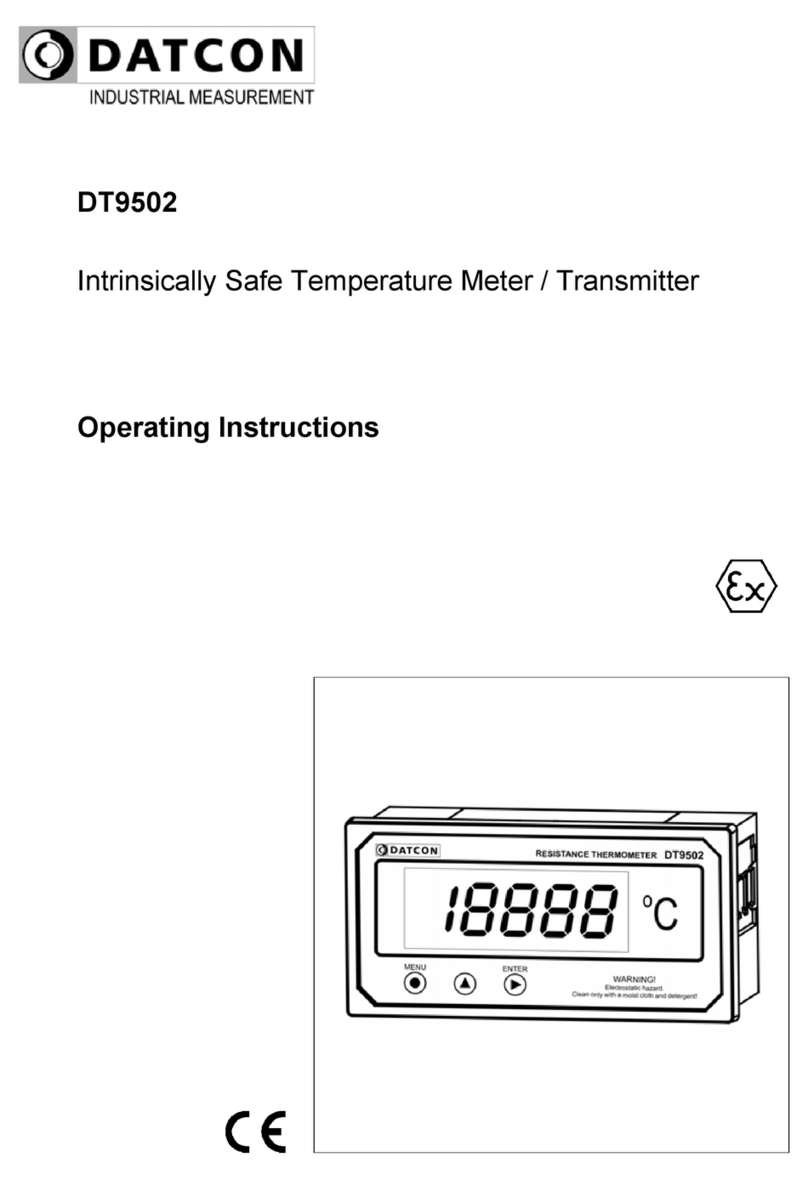
Datcon
Datcon DT9502 User manual
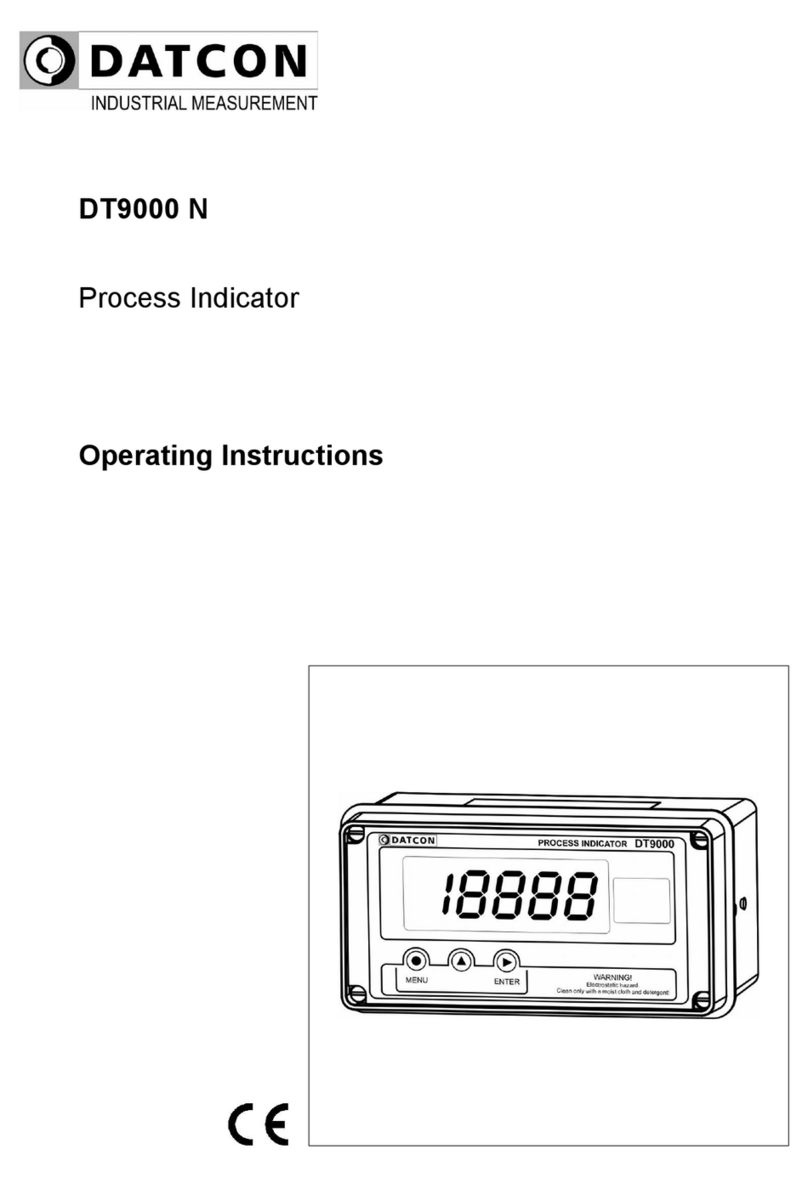
Datcon
Datcon DT9000 N User manual
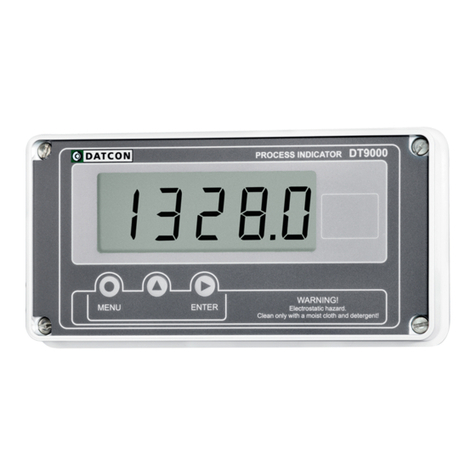
Datcon
Datcon DT9000 User manual
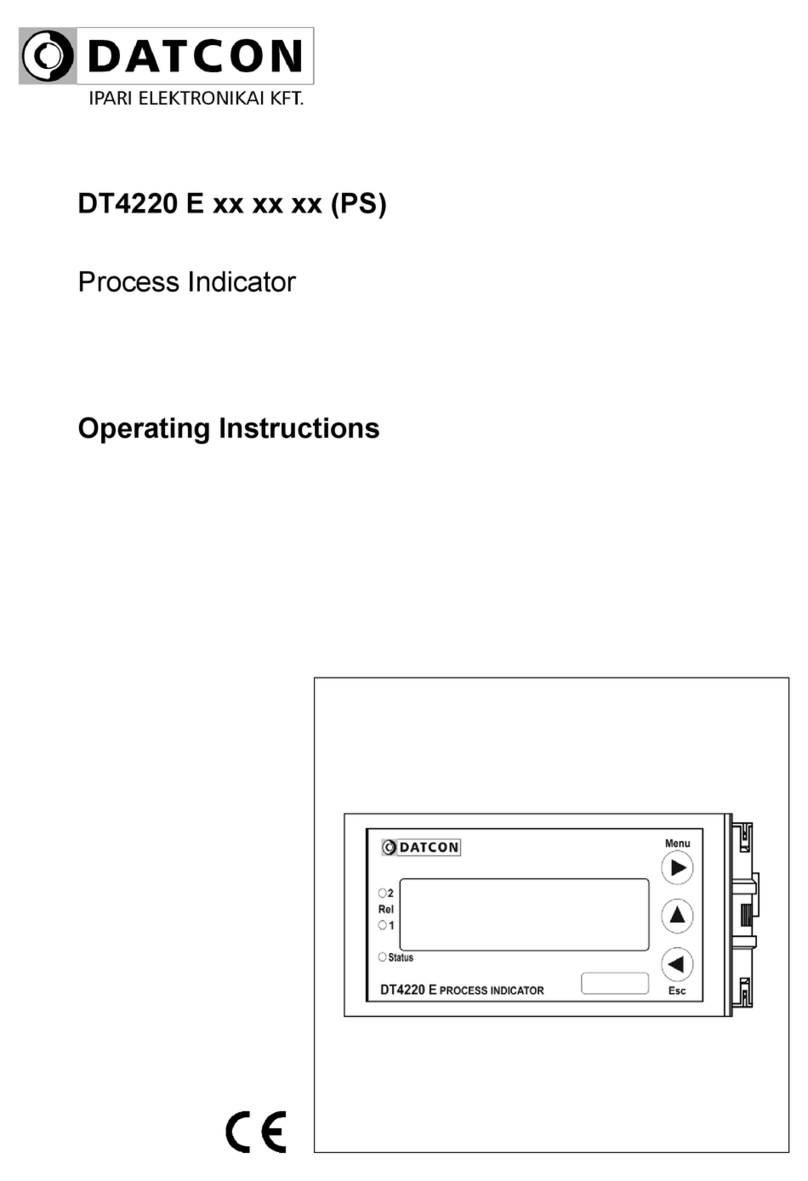
Datcon
Datcon DT4220 E Series User manual
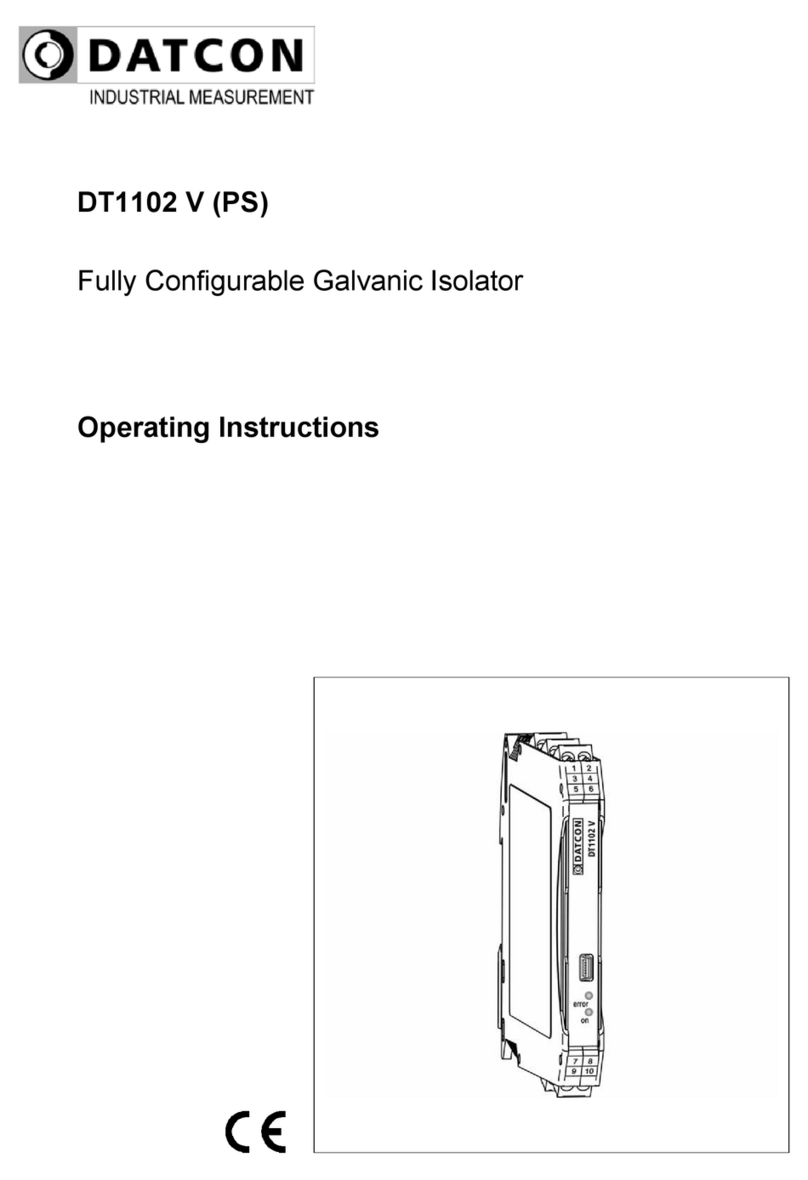
Datcon
Datcon DT1102 V User manual
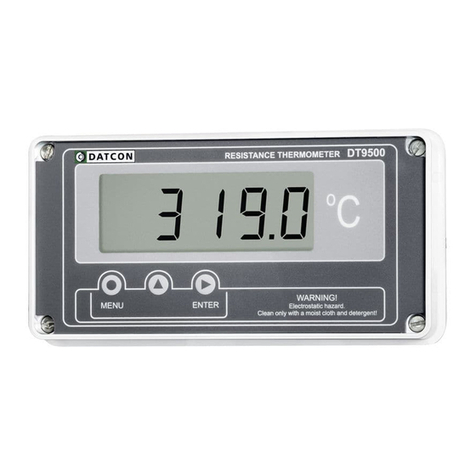
Datcon
Datcon DT9500 User manual
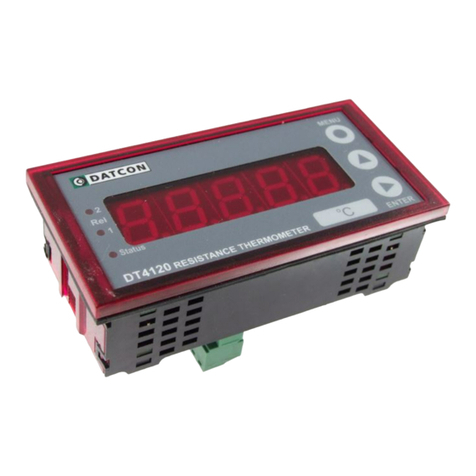
Datcon
Datcon DT4120 Series User manual
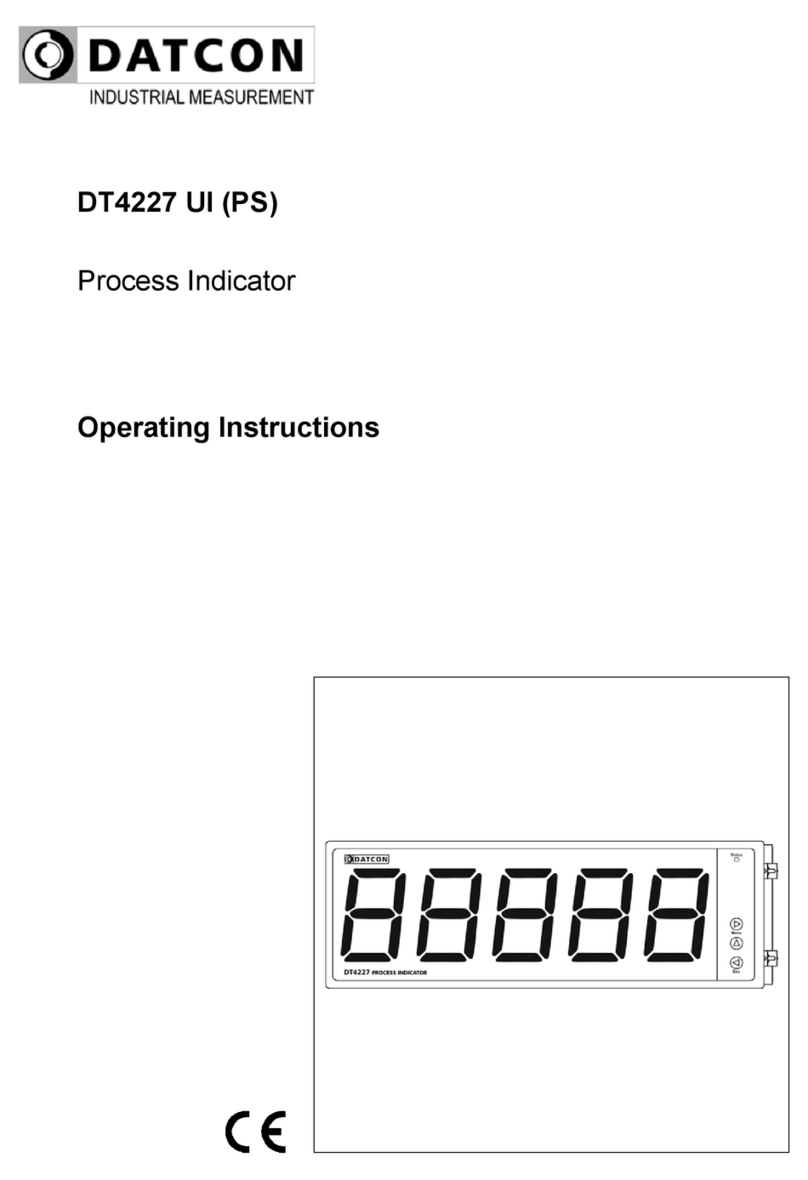
Datcon
Datcon DT4227 UI User manual
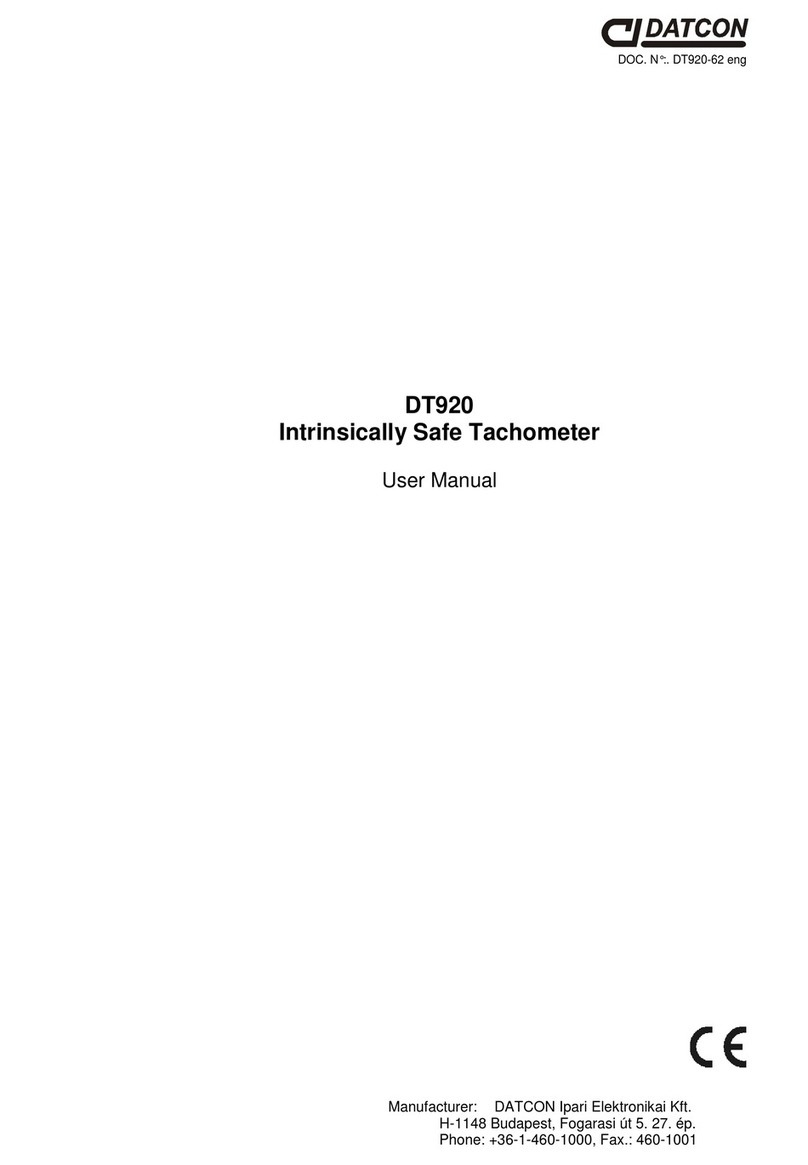
Datcon
Datcon DT920 User manual

Datcon
Datcon DT7000 User manual
